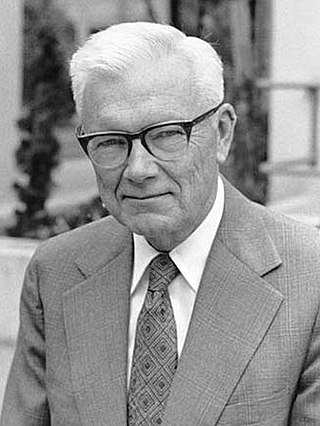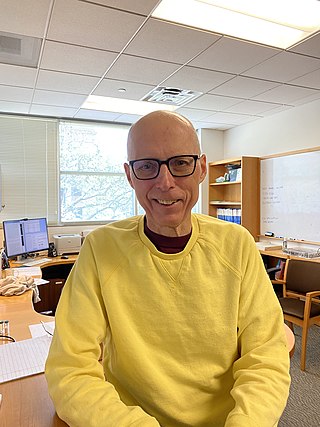Related Research Articles

The American Chemical Society (ACS) is a scientific society based in the United States that supports scientific inquiry in the field of chemistry. Founded in 1876 at New York University, the ACS currently has more than 155,000 members at all degree levels and in all fields of chemistry, chemical engineering, and related fields. It is one of the world's largest scientific societies by membership. The ACS is a 501(c)(3) non-profit organization and holds a congressional charter under Title 36 of the United States Code. Its headquarters are located in Washington, D.C., and it has a large concentration of staff in Columbus, Ohio.

Paul John Flory was an American chemist and Nobel laureate who was known for his work in the field of polymers, or macromolecules. He was a leading pioneer in understanding the behavior of polymers in solution, and won the Nobel Prize in Chemistry in 1974 "for his fundamental achievements, both theoretical and experimental, in the physical chemistry of macromolecules".

Eric Baer, is an American scientist and engineer known for his major research and educational contributions to polymer science and engineering. He is a leading pioneer in understanding the complex relationships between solid state structure, processing, and properties of polymeric materials and systems.
Izaak Maurits (Piet) Kolthoff was an analytical chemist and chemistry educator. He is widely considered the father of analytical chemistry for his large volume of published research in diverse fields of analysis, his work to modernize and promote the field, and for advising a large number of students who went on to influential careers of their own.
Carl Shipp "Speed" Marvel was an American chemist who specialized in polymer chemistry. He made important contributions to U.S. synthetic rubber program during World War II, and later worked at developing polybenzimidazoles, temperature-resistant polymers that are used in the aerospace industry, in fire-fighting equipment, and as a replacement for asbestos. He has been described as "one of the world's outstanding organic chemists" and received numerous awards, including the 1956 Priestley Medal and the 1986 National Medal of Science, presented by President Ronald Reagan.

Krzysztof "Kris" Matyjaszewski is a Polish-American chemist. He is the J.C. Warner Professor of the Natural Sciences at the Carnegie Mellon University Matyjaszewski is best known for the discovery of atom transfer radical polymerization (ATRP), a novel method of polymer synthesis that has revolutionized the way macromolecules are made.

Peter John Stang is a German American chemist and Distinguished Professor of chemistry at the University of Utah. He was the editor-in-chief of the Journal of the American Chemical Society from 2002 to 2020.

The Charles Goodyear Medal is the highest honor conferred by the American Chemical Society, Rubber Division. Established in 1941, the award is named after Charles Goodyear, the discoverer of vulcanization, and consists of a gold medal, a framed certificate and prize money. The medal honors individuals for "outstanding invention, innovation, or development which has resulted in a significant change or contribution to the nature of the rubber industry". Awardees give a lecture at an ACS Rubber Division meeting, and publish a review of their work in the society's scientific journal Rubber Chemistry and Technology.
The Melvin Mooney Distinguished Technology Award is a professional award conferred by the ACS Rubber Division. Established in 1983, the award is named after Melvin Mooney, developer of the Mooney viscometer and of the Mooney-Rivlin hyperelastic law. The award consists of an engraved plaque and prize money. The medal honors individuals "who have exhibited exceptional technical competency by making significant and repeated contributions to rubber science and technology".
Leo Mandelkern was a polymer chemist and professor known for his contributions to the understanding of polymer crystallization, and for his contributions to education.

Maurice Morton was a polymer author, educator, and researcher. He was the first director of the University of Akron's Institute of Rubber Research, which in 1993 was renamed the Maurice Morton Institute of Polymer Science.
Timothy P. Lodge is an American polymer scientist.

Charles C. Price was an American chemist and president of the American Chemical Society (1965). He taught at the University of Illinois at Chicago, the University of Notre Dame, and the University of Pennsylvania.
Christopher Ward Macosko (1944) is an American chemical engineer and professor emeritus in the department of chemical engineering and materials science at the University of Minnesota. He is internationally known for his work in polymer science and engineering, especially in the areas of rheology and polymer processing. Macosko is an author of more than 500 academic papers, dozens of patents, and two books including the text: "Rheology: Principles, Measurements and Applications". He served as director of the Industrial Partnership for Research in Interfacial and Materials Engineering (IPRIME), a university-industry consortium at the University of Minnesota, from 1999 to 2018. Macosko and his wife Kathleen have been married since 1967 and are long-time residents of Minneapolis. They have four children and 12 grandchildren.

John A. Gladysz, an organometallic chemist, is a Distinguished Professor and holds the Dow Chair in Chemical Invention at Texas A&M University. Professor Gladysz is a native of the Kalamazoo, Michigan area. He obtained his B.S. degree from the University of Michigan (1971) and his Ph.D. degree from Stanford University (1974). He subsequently held faculty positions at UCLA (1974-1982) and the University of Utah (1982-1998). He then accepted the Chair of Organic Chemistry at the University of Erlangen-Nuremberg in Germany. In 2008, he returned to North America as a distinguished professor and holder of the Dow Chair in Chemical Invention at Texas A&M University.
Ronald G. Larson is George G. Brown Professor of Chemical Engineering and Alfred H. White Distinguished University Professor at the University of Michigan, where he holds joint appointments in macromolecular science and engineering, biomedical engineering, and mechanical engineering. He is internationally recognized for his research contributions to the fields of polymer physics and complex fluid rheology, especially in the development of theory and computational simulations. Notably, Larson and collaborators discovered new types of viscoelastic instabilities for polymer molecules and developed predictive theories for their flow behavior. He has written numerous scientific papers and two books on these subjects, including a 1998 textbook, “The Structure and Rheology of Complex Fluids”.
Judit Puskas is a Distinguished Ohio State University professor noted as co-inventor of the polymer used on the Taxus-brand coronary stent. She is the first woman to win the Charles Goodyear Medal, the highest honor conferred by the American Chemical Society's Rubber Division. Her research focuses on polymer engineering for breast reconstruction in cancer treatment, green polymer chemistry, biomimetic processes, biomaterials, living polymerization, polymerization mechanisms and kinetics, thermoplastic elastomers, polymer structure/property relationships, and polymer-bio interfaces.
Joginder Lal was a Goodyear Polymer Research Manager and expert in the synthesis and mechanism of the formation of high polymers.
Andy Haishung Tsou is a retired ExxonMobil materials scientist known for developing synchrotron X-ray scattering and atomic force microscopy techniques for polymer research, applying the techniques in service of development and commercialization of new polyolefin materials.
David John Lohse is a retired ExxonMobil materials scientist known for contributions on thermodynamics of mixing, nanocomposites for controlling permeability, neutron scattering of polymers, rheology of polymers.
References
- ↑ "In memory of James E. Mark" . Retrieved 1 January 2018.
- ↑ "James E. Mark brief bio". Archived from the original on 2016-03-04. Retrieved 12 Sep 2013.
- ↑ Mark, J. E.; Erman, B. (2007). Rubberlike elasticity: a molecular primer. United Kingdom: Cambridge University Press. ISBN 9781139461566 . Retrieved 4 February 2024.
- ↑ Mark, J. E. (1996). "Ceramic-reinforced polymers and polymer-modified ceramics". Polymer Engineering & Science. 36 (24): 2905–2920. doi:10.1002/pen.10692.
- ↑ Mark, J. E. (2004). "Some interesting things about polysiloxanes". Accounts of Chemical Research. 37 (12): 946–953. doi:10.1021/ar030279z. PMID 15609986.
- ↑ Mark, J. E. (2003). "Some recent theory, experiments, and simulations on rubberlike elasticity". The Journal of Physical Chemistry B. 107 (4): 903–913. doi:10.1021/jp020056a.
- ↑ "Division of Polymer Chemistry". polyacs.org/. ACS. 28 November 2017. Retrieved 19 September 2023.